

Managing your digital footprint - Digital Citizenship Adventures. Goal and overview Goal: The overall goal for this adventure is to help you understand how you project yourself to world on the Internet.
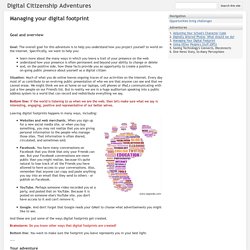
Specifically, we want to help you:learn more about the many ways in which you leave a trail of your presence on the webunderstand how your presence is often permanent and beyond your ability to change or deleteand, on the positive side, how these facts provide you an opportunity to create a positive, on-going public presence about yourself as a digital citizen Situation: Much of what you do online leaves ongoing traces of our activities on the Internet.
Every day most of us contribute to an evolving public presentation of who we are that anyone can see and that we cannot erase. We might think we are at home on our laptops, cell phones or iPad,s communicating with just a few people on our Friend's list. The Principal of Change – Stories of learning and leading. Social Media in the Classroom. By Lani Aquino “We’re raising children, and we don’t know what’s coming,” was a quote that made me sit up and take notice recently.
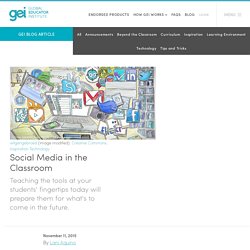
As Mark Beeson painted a picture of how comical it would have been to have children limbering up their thumbs ten years ago in preparation for all that would be at their fingertips today, it made me pause and think about what’s to come. What devices, apps, and sources of information will be the new normal when my two year old sits in a classroom? When did I become a person that utters the phrase “I remember when…” as my children and students cruise along the information superhighway? 10 Social Media Skills for Every Modern Teacher [Infographic] Social media skills have an increasingly useful presence in modern classrooms.
![10 Social Media Skills for Every Modern Teacher [Infographic]](http://cdn.pearltrees.com/s/pic/th/social-teacher-infographic-129434051)
Social Media for Teachers: Guides, Resources, and Ideas. Although students are evermore connected to the social web, many of these networks remain out-of-class digital playgrounds where students congregate.
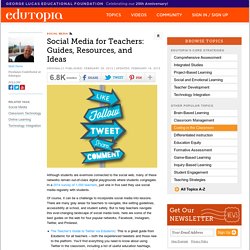
In a 2014 survey of 1,000 teachers, just one in five said they use social media regularly with students. Of course, it can be a challenge to incorporate social media into lessons. There are many gray areas for teachers to navigate, like setting guidelines, accessibility at school, and student safety. 11 Tips For Students To Manage Their Digital Footprints. 11 Tips For Students To Manage Their Digital Footprints by Justin Boyle If you’ve scratched your head over suggestions to manage your “digital footprint,” you aren’t the only one.
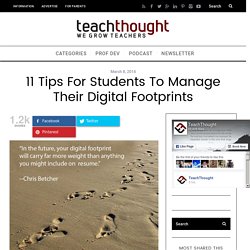
A surprisingly large percentage of people have never even heard the phrase, let alone thought about how to manage theirs responsibly. Among students, the percentage is probably higher. 5 Ways to Make a Positive Digital Footprint! For more information, watch the following video on digital footprints.
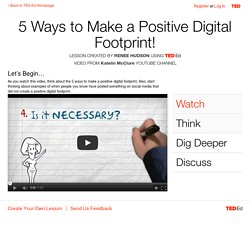
There are excellent resources about digital footprints on the website: Cybersmart. On this website, you can take a quiz to see how cybersmart you are. There are links for kids, teens, parents and teachers, including information about cyberbullying, identity theft, excessive Internet use, plus many more. Another website that focuses on students as the audience is Kidsmart. This website gives a quiz on being digitally smart. Why Teachers Must Have a Digital Footprint. Nov 27 2013 It’s so funny.
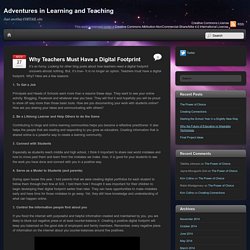
Looking for other blog posts about how teachers need a digital footprint uncovers almost nothing. But, it’s true– It is no longer an option. Teachers must have a digital footprint. Why? 1. Principals and Heads of Schools want more than a resume these days. 2. Contributing to blogs and online learning communities helps you become a reflective practitioner. 3. Especially as students reach middle and high school, I think it important to share real world mistakes and how to move past them and learn from the mistakes we make.
Teachers, Take Care Of Your Digital Identity. One of the areas of focus for me in my district this year is teaching teachers and students how to take control of their digital identity and turn it into something positive and something they can be proud of.
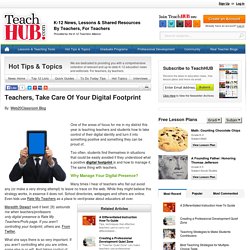
Too often, students find themselves in situations that could be easily avoided if they understood what a positive digital footprint is and how to manage it. The same thing with teachers. Why Manage Your Digital Presence? Many times I hear of teachers who flat out avoid any (or make a very strong attempt) to leave no trace on the web. While they might believe this strategy works, in essence it does not. Tips, techniques that effective teachers use to carry out differentiated... A “Teacher Quiet Zone” can make teachers use professional development time to... Twitter. 10 Things Your Students Should Know About Their Digital Footprints.
Building a digital legacy is an issue I believe doesn’t garner enough attention in our personal and professional lives.
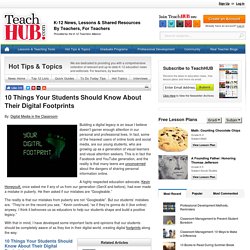
In fact, some of the heaviest users of online tools and social media, are our young students, who are growing up as a generation of visual learners and visual attention seekers. This is in fact the Facebook and YouTube generation, and the reality is that many teens are unconcerned about the dangers of sharing personal information online. A highly respected education advocate, Kevin Honeycutt, once asked me if any of us from our generation (GenX and before), had ever made a mistake in puberty. He then asked if our mistakes are “Googleable.” The reality is that our mistakes from puberty are not “Googleable”.
With that in mind, I have developed some important facts and opinions that our students should be completely aware of as they live in their digital world, creating digital footprints along the way. 1.) 3.) 9 Ways to Use Social Media in Your Classroom. It’s overwhelming to think about packing up the summer, heading back to the classroom, and adding a new instructional strategy to your already overflowing toolbox.
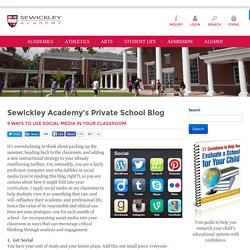
Yet, ostensibly, you are a fairly proficient computer user who dabbles in social media (you’re reading this blog, right?) , so you are curious about how it might fold into your curriculum. I apply social media in my classroom to help students view it as something that can–and will–influence their academic and professional life, hence the value of its responsible and ethical use. Here are nine strategies–one for each month of school– for incorporating social media into your classroom in ways that can encourage critical thinking through analysis and engagement. 1. 2. 3.
Other ideas are to have a class twitter account and talk to other classes such as #kinderchat or have a twitter competition with another class. 4. 5. 6. 7. 8. 9. How to Use Social Media as a Learning Tool. Social media is an ingrained part of today’s society. Our students are constantly on Instagram, Facebook, Twitter, and likely many sites we’re not hip enough to know about, and by reading this blog, you’re interacting with social media at this very moment.
If you want to bring the “real world” into the classroom, consider integrating social media into your lessons. No Longer a Distraction Image via Flickr by Sean MacEntee When used carefully, social media can be a useful tool rather than a distraction.